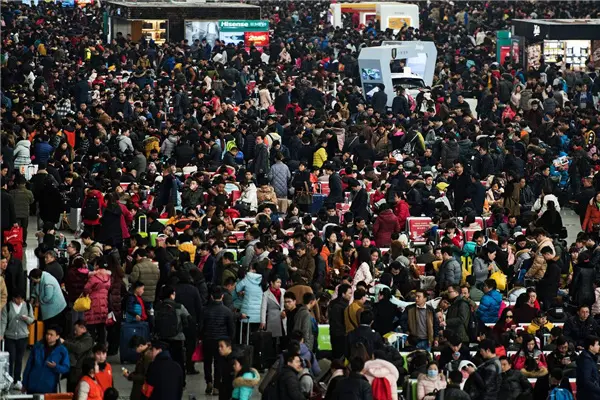Passengers crowd the Shanghai Hongqiao railway station as they wait to board their trains to head to their hometowns for the Lunar New Year holiday, in Shanghai on February 3, 2016.PHOTO:AGENCE FRANCE-PRESSE/GETTY IMAGES
(THE WALL STREET JOURNAL) A unit of Chinese internet giant Baidu has developed an algorithm that can predict crowd formation,whichit sayscould be used to help warn authorities and individuals of unusually large crowds that could lead to public-safety threats.
On Tuesday, Baidu’s Big Data Labpublished a studythat showed that aggregated data from Baidu Map routesearches, whencorrelated with the crowd density of the places people searched for can predict future crowd formations at a certain place and at a certain time.
Wu Haishan, a senior research scientist at Baidu and an author of the report, said his team started to focus on crowd-formation predictions after theShanghai stampede on New Year’s Eve in 2014, which killed more than 30 people.
“Our algorithm is able to use crowd data from Baidu maps to predict how many people will be [at a certain location] in the next two hours,” Mr. Wu said.
Thealgorithmis another example of how Baidu, which has more than 70% of the market sharein Chinese Internet search, is using its big data to analyze social and economic issues, which often are rife with sensitivity.Big Data Lab researchers have also used positioning data tomeasure people flows in China’s “ghost cities”and said in a report last year that not all of them are empty year round.
Traditionally, crowd formation predictions are detected through video sensors and computer vision technology, the report said.
The Baidu algorithm could be used to send early warning signals of large crowds to travel authorities, local governments and companies that operate stadiums or concert venues by looking at route queries placed on Baidu maps about 30 minutes to two hours before an event. Users could set their own threshold to determine when warnings should trigger an alert. Mr. Wu said there are no privacy issues with the algorithm because it only uses aggregated data, so individual users can’t be identified.
Rescuers help victims of a stampede by New Year revellers on Shanghai's historic riverfront on January 1, 2015.PHOTO:AGENCE FRANCE-PRESSE/GETTY IMAGES
Other researchers who have studied ways to use mobile phone data to predict large crowds have said it could also measure gatherings such as protests. Last year, a team from the University of Warwick in Englandstudied tweets tagged by location and mobile phone usage in Milanto quantify crowd sizes. The study concluded that, “our findings suggest that data generated through our interactions with mobile phone networks and the Internet may allow us to gain valuable measurements of the current state of society.”
A Baiduspokesmansaidcharting where protests are likely to form wasn’t the aim of its research, adding that Chinese law enforcement would most likely be aware of social-unrest developments long before a few hours.
While Baidu stressed that the report is only “an academic paper at this point,” Mr. Wu said the research or algorithm could be shared with product development in the future or easily opened up to local governments, authorities and venue operators.
In the future, it could also be available to general users in Baidu Maps, Mr. Wu said. Such a tool would be a natural extension of Baidu’s heat-map function, which for several years has let users see the crowds at popular tourist sites. But this algorithm, if implemented on a large scale, could show crowd density at, say, the local noodle shop during lunch rush hour.
While the researchers devised the algorithm as a public service, it could also be used for other purposes. Shanghai’s Disneyland, whichunveiled a two-tiered pricing system last monthto “allow the park to manage the extraordinary anticipated demand,” could use this data to predict surges in park-goers, for example.
 简体中文
简体中文

